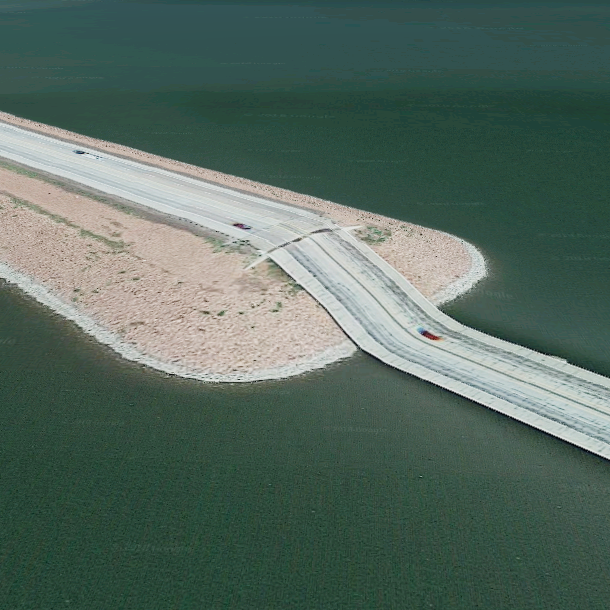
Twice this week I found myself carefully crawling through a detailed digital landscape, searching for anomalies distributed throughout an enormous visual model of a real world location.
195 gigapixel Shanghai panorama
Cubist Google Earth (Are.na channel)
I will immediately click pretty much anything that has the word ‘gigapixel’ in it. As soon as I saw this tweet from Kyle McDonald late last night I knew what to do.
thinking about the people crossing the seams of this 195 gigapixel panorama https://t.co/dXPOBH2ddZ pic.twitter.com/z1bOGLzC7n
— Kyle McDonald (@kcimc) December 19, 2018
As defined by Noah Webster back in the early 1800s, “a gigapixel image is a digital image bitmap composed of one billion pixels, 1000 times the information captured by a 1 megapixel digital camera. A square image of 32,768 pixels in width and height is one gigapixel.” This Shanghai panorama is made up of 195 of those.
In other words, you can zoom in on distant buildings and people and still maintain a reasonably high level of crisp resolution. Many of us have experienced the thrill of doing this at some point, but what interested me about McDonald’s tweet was the focus on the anomalies at the seams.

The 195 gigapixel image is made up of numerous sub-images, stitched together. In the Shanghai Panorama, the various sub-images were captured at nearly the same time, but it wasn’t exact. On the “seams” of the images, where the edges meet, it’s possible to spot people that were photographed at two separate times, a few feet apart. This causes the same person to occupy two separate places in the full, aggregated panorama, with one standing on an edge adjacent to the other. Meanwhile, the “edges” of the sub-images are effectively invisible, as they can only be inferred from identifying anomalies in the image.
The experience of searching a giant image for these human doubles is very strange. I found in at once soothing and somewhat disturbing. Soothing to slowly float in and out of the daily lives of so many people unaware that this particular, inconsequential moment would be captured and held onto for so much longer, and soothing to pan the camera’s view along the streets and come across recognizable city inhabitants like street food cooks, sanitary workers, and businessmen sitting on stairs.
Somewhat disturbing to feel like a surveillance officer, although I assume that anyone stepping foot outside in Shanghai realizes that they are probably on camera somewhere. But still, the incredible detail on offer here, especially when looking almost straight down at the plazas below where the resolution is sharpest, naturally draws the mind to trivial investigative matters. Who was a tourist and who was walking to work, and how long had the group of five people been searching the ground for some lost item underneath or around a wheelchair?
Searching for doppelgängers at the seams brought me back to reality, somewhat ironically. McDonald took a few screenshots of the ones that he found, and I came across a few myself. The process of identifying them is not unlike Where’s Waldo. There are many false positives, like pairs of people wearing nearly the same thing or striding in unison, side by side. But at some point, a key piece of evidence emerges.
In the image below, it seems possible that two different people could be carrying the same flag, with similar plain black shoes and ponytailed hair. But the same blue streak appears on both of their backpacks, and thats enough for me. The large shoulder bag is easily noticed in the image at the top of this post, while the wristwatches and umbrellas rotated at exactly the same angle stand out in the image above.

On another side of the spectrum of image quality and representation, I was introduced to the idea of Cubist Google Earth via this Are.na channel. If you don’t know what Are.na is but you’re interested in the idea of a visually-oriented organizational, open-ended inspirational/creative tool, you should check it out. Far from the hyper-resolution gigapixel image of Shanghai, the 3D layers in Google Earth are typically distorted, glitched representations of the structures they are meant to represent. A glitch on a highway comes to resemble a civil engineering mishap in SimCity (or the Cities: Skylines simulation game, which is much better than SimCity but doesn’t have the Kleenex/Band-Aid style of brand recognition, perhaps because it has a colon in the middle of its title).

As the name indicates, many of the images found in Cubist Google Earth are made up of buildings that seem to be shown from several different angles at once.

Since the Cubist Google Earth channel is “open”, which means anyone can add links/images to it, I decided to go on a hunt of my own. I quickly headed to LaGuardia airport in Queens and found a mutated set of planes that reminded me of the Shanghai Panorama “seams” experience.

I have some more material related to this (a delightful evening spent looking for broken telephone wires in Google Map Streetview), but I’ll put a lid on it for now. I don’t have comments turned on for this website because it’s embarrassing when the majority of a website’s comments are spambots, but if you have your own examples of “seams” in panoramic pictures, Google Earth images, or elsewhere, I’d love to see them.

